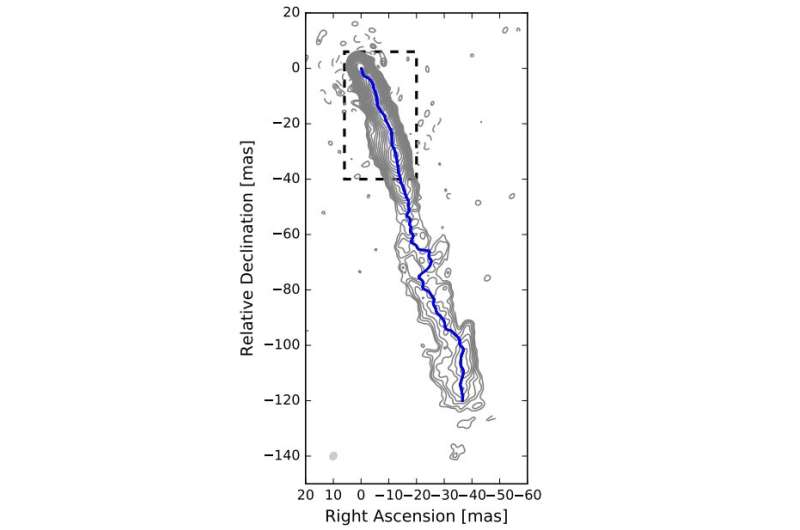December 11, 2019 report
Relativistic jet of the blazar S5 0836+710 investigated in detail

Using very long baseline interferometry (VLBI), astronomers have performed comprehensive multiwavelength observations of the radio emission in the blazar S5 0836+710. The new research, presented in a paper published December 2 on arXiv.org, reveals important insights about the structure the blazar's relativistic jet.
Powered by supermassive black holes (SMBHs), quasars, or quasi-stellar objects (QSOs), are extremely luminous active galactic nuclei (AGN) with luminosities even thousands of times greater than that of the Milky Way galaxy. They emit jets from their central regions, which can be even larger in extent than their host galaxies.
Blazars are very compact quasars associated with supermassive black holes at the centers of active, giant elliptical galaxies. Their characteristic features are relativistic jets pointed almost exactly toward the Earth. However, the detailed mechanisms of ejection and collimation of jets are still poorly understood, and more studies of this phenomenon are required to improve our knowledge on the subject.
At a redshift of 2.18, S5 0836+710 is a powerful blazar with a one-sided relativistic jet at parsec scales, having a helical structure. A team of astronomers led by Laura Vega-García of Max Planck Institute for Radio Astronomy in Bonn, Germany, decided to take a closer look at this jet. By combining the data from VLBI array of radio telescopes and from the Spektr-R satellite, they obtained multiwavelength images of S5 0836+710, which allowed them to learn more about the internal structure of the relativistic jet in this object.
"The RadioAstron observations at wavelengths of 18 centimeters, 6 centimeters, and 1.3 centimeters are part of the Key Science Program for imaging radio emission in strong AGN. The internal structure of the jet is studied by analyzing transverse intensity profiles and modeling the structural patterns developing in the flow," the astronomers wrote in the paper, explaining the methods employed for the observations.
As a result, the researchers acquired images of the blazar's jet with an unprecedentedly high angular resolution, reaching down to 15 microarcseconds at 22 GHz, which corresponds to a linear scale of about 0.42 light years. This high-resolution imagery provided detailed information about the jet's structure.
In particular, the internal structure of the jet was studied by analyzing the ridge line of the jet. The research identified several oscillatory patterns in this ridge line, and the astronomers assume that they could be explained in terms of the Kelvin-Helmholtz instability.
"The ridge lines were represented with a simple model as the sum of multiple oscillatory terms. The parameters of these oscillatory modes are modeled and explained in the framework of a Kelvin-Helmholtz instability that develops in the flow," the paper reads.
Based on this hypothesis, the researchers estimated that the jet Mach number and the ratio of the jet to the ambient density are at a level of about 12 and 0.33, respectively. However, more detailed numerical analysis of the jet stability is required to verify this scenario and the obtained values.
More information: Multiband RadioAstron space VLBI imaging of the jet in quasar S5 0836+710, arXiv:1912.00925 [astro-ph.GA] arxiv.org/abs/1912.00925
© 2019 Science X Network



















